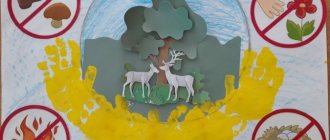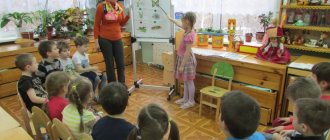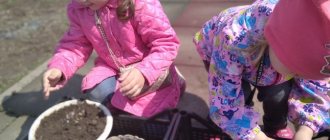Circle on environmental education of children in the preparatory group
Circle
on environmental education of preschool children
"Rowanka" in the preparatory group
Head: Vasilenko E.V.
Educator
Work schedule
The club operates during the academic year (September – May inclusive), once a week – Tuesday/Friday at 16.00
. The circle plan is designed for a year. The number of children attending the Ryabinka circle is 10 children. Children's age: from 6 to 7 years.
Explanatory note
“The world surrounding a child is, first of all, the world of nature, with an endless wealth of phenomena, with inexhaustible beauty.
Here, in nature, is the eternal source of the child’s mind” V. Sukhomlinsky.
The Ryabinka circle has an environmental focus, which is determined by its particular relevance
environmental education in modern conditions. With the beginning of the third millennium, the environmental problems that arose earlier not only did not disappear, but continued to deepen. In the 21st century, their solution takes on the character of a factor in the survival of mankind.
Since environmental problems have come to the fore in recent years, it is necessary to deepen children’s knowledge in this area. Introducing children to environmental culture must begin from childhood, since at this age it is easiest to introduce children to nature, teach them to love and protect nature. Children learn to observe changes occurring in nature and draw conclusions. By studying in a circle, children enrich their knowledge base with new knowledge about natural phenomena. This instills in them curiosity, a caring attitude towards nature, and a desire to know more. When studying the topics provided by the circle, imaginative and concrete thinking develops; visual and auditory memory; speech, attention, perception.
The content of the circle was based on the partial program of S.N. Nikolaeva “Young Ecologist” and the program of additional environmental education for children of senior preschool age E.Yu. Borzova “Ecological Basket”, which involves the formation in children of a consciously correct attitude towards natural phenomena and objects that surround them and with which they become acquainted in preschool childhood and the formation of an ecological culture in preschoolers through their familiarization with the value foundations of their relationship to nature.
primary goal
The work of the circle is to form in children elements of environmental consciousness, the ability to understand and love the world around them and nature.
The work of the Ryabinka circle is designed to solve the following problems
:
1. Development in children of the subjective experience of emotional and sensory generalization with nature and the sociocultural environment, ideas and elementary concepts about the surrounding world, interconnections and relationships in it, as the basis for the development of environmental consciousness and ecological culture of the individual.
2. Fostering an emotional and value-based attitude towards the natural environment.
3. Development of experience in practical and creative activities in the implementation and consolidation of knowledge and emotional and sensory impressions obtained through interaction with the natural environment, as well as in the reproduction and preservation of the natural environment, development of a sense of discoverer.
Methods
, used to implement the work of the circle:
- Visual methods:
— excursions, targeted walks;
— observations;
- showing fairy tales (by teacher, children);
- examination of book illustrations and reproductions;
— conducting didactic games;
- Verbal methods:
- reading literary works;
- conversations with elements of dialogue, summarizing the stories of the teacher.
- Game methods:
- conducting a variety of games (sedentary, role-playing, didactic, dramatization games, etc.);
- asking riddles;
— holding quizzes, competitions, themed evenings.
- Practical methods
— organization of children’s productive activities;
— design of a herbarium of plants, collections of seeds, fruits;
- production of fairy tales, excerpts from literary works;
- making visual aids with children.
When building the system of work of the environmental circle, we paid special attention to the following main directions
.
- The educational and entertainment direction aims to introduce children to the components of living and inanimate nature, the influence of human activity on these components in a playful and entertaining way.
- The practical direction is the study of flora and fauna, landscapes of the native land, associated with practical matters (environmental actions, work in the garden, feeding birds, planting flower beds, etc.).
- The research direction is carried out within the framework of productive activities, excursions, observations, and experiments.
Expected Result
interactions with children:
- Must know and follow the basic rules of behavior in nature (a way to safely interact with plants and animals)
- Showing interest and kindness towards natural phenomena and objects;
- Helping each other, caring, friendly attitude towards nature, showing creativity.
Long-term work plan for the Ryabinka circle
2015 – 2021 academic year
| Subject | Tasks | Content |
| "Flowers in the autumn plot" | To consolidate children's knowledge about autumn garden flowers: differences in appearance, stages of seed ripening. Clarify children's ideas about gardening in the fall. Activate children's vocabulary with words meaning the names of garden flowers. | Making riddles, d/game “Guess by the description”, observation. |
| "Autumn Harvest" | Strengthen children's knowledge about vegetables and fruits. Clarify children's knowledge about caring for vegetables. Cultivate hard work. Activate children's vocabulary with words denoting vegetables and labor actions. | Reading poems “Hello, autumn!” E. Blaginina, observation, conversation “What grows in the garden?” |
| "Autumn in white mists" | Clarify children's knowledge about such a natural phenomenon as fog. Develop cognitive activity. Activate children's vocabulary: fog, damp, damp, thick cover. | Conversation “What is this fog?”, reading poetry, asking riddles, observation. |
| “Now a birch tree, now a mountain ash” | Continue to familiarize children with the characteristic features of trees and seasonal changes. Cultivate a love for nature. | Reading poems: “Birch Tree”, “Rowan Tree”, d/game “Describe the Tree”, asking riddles, observation |
| "Six-legged and eight-legged" | Continue to form children’s ideas about insects and spiders, about the features of their life in the fall, develop children’s abilities to model signs and concepts | Consideration of the “Insects” scheme; working with cards - tasks; inventing; Reading K. Chukovsky's “Fly-Tsokotukha”; story |
| “Features of insect movement” | Expand children's understanding of the methods of movement of insects, develop cognitive interest in the life of living small creatures, and cultivate curiosity | Conversation; working with cards, watching the video material “Microcosmos” |
| “Deceptive coloring. Protection" | To give children an idea of coloring as a way of protection from enemies, to demonstrate the dependence of coloring on the insect’s habitat, to develop cognitive interest in nature | Riddles, looking at the poster “Who hid where?”; Conversation “Why do insects have such colors?”, D/game “Help the insect hide” |
| “Where and how do insects winter?” | Introduce children to the metamorphosis of insects. Show, using the example of insects, that by winter nature only freezes, only to be reborn in the spring. To form an interest and kind attitude towards these living beings | Listening to “Sounds of Insects”; Conversation; making a collage “Where do insects winter?” |
| "Flying Flower" | To interest children in learning the secrets of the life of butterflies, to help children enjoy the external beauty of these insects | Conversation “Who are butterflies?”; looking at illustrations about butterflies, story, game “Butterflies in the Meadow”, applique “Butterfly” |
| “Who lives four lives?” | Expand children's understanding of the life of butterflies, introduce them to the stages of butterfly development. | Mystery; Demonstration of illustrations of the stages of butterfly development; reading the story “A butterfly has wings”; d/game “Confusion” |
| "Amazing facts from the life of insects" | Expand and deepen children’s understanding of the life of insects, introduce them to record-breaking insects; develop sympathy for these animals. | Conversation; reviewing the encyclopedia; Story; D/game “Continue the phrase” |
| Quiz “Six-legged babies” | Summarize children's knowledge about insects, spiders and other small animals; develop speech, attention, reaction speed; educate children's environmental culture | Abstract |
| “The ancestors of modern animals are dinosaurs” | Introduce children to the history of the appearance and disappearance of dinosaurs; expand your horizons; develop thinking, speech, curiosity | Conversation “Ancient Planet”, d/pause “Dinosaurs”, story; n/a Game "Prehistoric Earth" |
| "Life under a microscope" | Expand children's ideas about forms of life, develop the need for a healthy lifestyle, and cultivate a caring attitude towards themselves and others | Story; examining objects and skin under a magnifying glass; conversation, experience, d/game “Good-bad” |
| “Where does mold come from?” | Expand children's understanding of the smallest living organisms - mold fungi, develop children's cognitive interest in living organisms | Examining moldy food products, the “Moldy Bread” experiment, examining mold through a magnifying glass, a teacher’s story. |
| “What are mammals?” | Generalize and expand children's understanding of mammals as living beings; teach to distinguish between the concepts of “mammals”, “beasts”, “animals”, develop children’s ability to model | Conversation “Signs of mammals”, d/game “Help the animals find their home”, d/game “Relocation”, game “Mysterious Guest” |
| "Exotic animals" | To clarify and deepen children’s knowledge about exotic animals, develop interest in them, and cultivate a kind and sensitive attitude towards animals | Game “Journey to Africa”, conversation, sketch “Menagerie”, story about nature reserves |
| "Marine Mammals" | To form an idea of marine mammals, the characteristics of movement, nutrition, breathing, to expand children's horizons | Research activities, Reading the story “Dolphins”, watching a video, Conversation “Who are walruses and seals?”, story |
| "Inhabitants of the Living Corner" | Expand children's ideas about the life of the inhabitants of a living corner, the features of caring for them, develop cognitive interest, and cultivate curiosity. | Conversation, observation, looking at illustrations. |
| "About cats and dogs" | Introduce children to the variety of breeds of cats and dogs. Reveal their meaning for a person; cultivate curiosity. | Conversation, looking at illustrations, children telling about their pets, drawing a favorite pet |
| "Homeless animals" | Show the damage stray cats and dogs cause; instill in children a caring attitude towards pets. | Riddles, looking at illustrations, conversation “The Sparrow is our Frequent Guest”, teacher’s story, reading “The Great Tit” |
| "Teeth, Noses, Ears" | Concretize children's ideas about ways to adapt the life of animals on Earth, develop children's abilities, thinking, imagination, speech, cognitive interest in nature | Conversation “Why do animals need noses, teeth, ears?”, looking at illustrations, game “Fox and Mice”, game “Who’s Hiding?” |
| “What kind of paws are there? Animal tracks" | Expand children’s understanding of the structure of paws and methods of movement of animals, consolidate ideas about the structure of animal bodies, teach children to “read” animal tracks | Conversation, comparison of animal paws, game “What kind of animal?”, “Who walked in the snow?” |
| "Masters of escaping from enemies" | Concretize children's ideas about ways to protect animals from enemies; develop environmental literacy. | Conversation “How are we alike?”, d/game “Who is afraid of whom?”, game “Who escapes from enemies how?” |
| “What grows where? Who lives where?" | Summarize and systematize children’s ideas about plants and animals of various habitats, show the adaptability of organisms to living conditions | D/games “Plant the plants”, “Animals got lost”, words/game “Riddle, and we will guess” |
| "Black Gold" | To introduce children to the mineral resource – oil, to cultivate a caring attitude towards nature and its riches | Teacher's story, research activity, conversation about the harm caused to nature. |
| "Tundra and Man" | Summarize children's knowledge about the tundra, its flora and fauna, indigenous peoples, and cultivate a caring attitude towards the nature of their native land | Game “Chain”, “What’s extra?”, conversation “What are you like, Yamal?”, looking at illustrations |
| "The planet is sick" | Clarify and expand children’s understanding of air, its composition, wind, talk about the main causes of air pollution, and develop logical thinking. | Story about air, experiment “Properties of Air”, conversation. |
| “Where does the water in the tap come from?” | To generalize children’s ideas about water as a source of life, expand their ideas about the importance of water supply, and cultivate a caring attitude towards the nature of their native land | Conversation “Where does the water in the tap come from?”, story, experience in water purification |
| “What is ecology?” | Arouse children's interest in solving environmental issues. Introduce the concepts of “environment”, “ecology” | Looking at photographs “Environmental anxiety”, conversation, reading a story, drawing “A Gift to Planet Earth” |
| “Planet Earth is our cosmic home” | Introduce children to a globe - a model of the globe - and a map, give basic ideas about the human home and home - nature, and cultivate a caring attitude towards the Earth - your home. | teacher's story, Conversation, game - simulation "Living Planet" |
| “Let’s save the wonderful world of plants and animals” | To consolidate children's knowledge about the world of plants and animals, to cultivate in children a caring attitude towards the plant and animal world, and emotional responsiveness. | Conversation, d/game “What trees grow in the forest?”, game “What? For what?”, reading K. Balmont’s poem “For Mushrooms” |
| "Sun on the grass" | To clarify children’s knowledge of a flower, the ability to find it by leaves, the shape of the inflorescence, to develop children’s interest in working with paint. Continue to arouse children's interest in fresh flowers. | Reading poetry, finger gymnastics, productive activities |
| "Who needs water?" | To clarify and expand children’s knowledge about water, its properties, role in human life and living organisms, to provide an understanding of the main causes of water pollution and its consequences. | Conversation on issues, examination of illustrations “Everyone needs water”, experience, writing a story. Drawing environmental signs |
| "Blooming trees" | To help familiarize children with the peculiarities of the spring state of fruit trees, to develop the ability to establish the simplest connections: changing conditions in the environment, to cultivate interest in plants, respect and care. | conversation about apple trees, cherries, lilacs. d/game “Which tree is the flower from, game - imitation “Collect nectar” |
| “What are clouds, rain, thunderstorm?” | Give the concept of water evaporation, cloud formation, and electrical discharges in an accessible form. Introduce children to the rules of behavior during a thunderstorm. | Observation, looking at illustrations, reading. |
| Quiz “Be a friend of nature” | Summarize and systematize children’s knowledge about nature and man’s place in it, develop attention, thinking, speech, cultivate curiosity, and respect for nature. | Abstract |
Bibliography:
- Nikolaeva S.N. Young ecologist: Program for environmental education of preschool children / S.N. Nikolaeva – M.: Mozaika-Sintez, 2002. – 128 p.
- Environmental education of preschool children: A manual for preschool education specialists / Compiled by Nikolaeva S.N. - M.: LLC "- 1998. - 320 p.
- Nikolaeva S.N. Methods of environmental education in kindergarten: Working with children of middle and senior groups of kindergarten: A book for kindergarten teachers / S.N. Nikolaev.- M.: Education - 1999. - 207 p.
- Zubkova N.M. A cart and a small cart of miracles: - M; Mosaic-Synthesis, 2009. - 79 p.
- Organization of children's activities during a walk. Senior group/aut.-comp. T. G. Kobzeva, I. A. Kholodova, G. S. Aleksandrova. – Volgograd: Teacher, 2011. – 330 p.
- Borzova E.Yu. Ecological basket. Program of additional environmental education for preschool children: - Salekhard: GOU DPO "YANOIPKRO", 2010. - 136 p.
- https://www.ivalex.vistcom.ru/konsultac409.html
Why do we need didactic games on ecology in preparatory groups of preschool educational institutions?
Didactic games on ecology in the preparatory group occupy a special place. In younger groups, children are just beginning to explore the world, but middle-aged or older children form their own ideas about the world around them. Therefore, environmental education of preschool children is the starting point and basis of his own vision.
Discussion of environmental problems in kindergarten
From this moment on, all the child’s knowledge will be conscious and become part of his personality. Therefore, it is easiest to instill a caring attitude towards nature in a playful way.
For your information! While playing, the baby feels better, rejoices, and experiences deeper emotions. However, group activities develop cohesion and make learning more fun.
At the request of the Federal State Educational Standard, classes are carried out throughout the year. They should not be interrupted. After a course of didactic games in kindergarten, the child should know the rules of attitude towards nature.
Children playing in a preschool
Ecological games in the preparatory group: card index with goals
Educators can either come up with activities on their own or take ready-made options from teaching aids and other sources. On the topic of environmental studies, the preparatory group has an extensive card index of didactic games on ecology.
Guessing vegetables with your eyes closed
"Guess"
Goal: to teach the child to tactilely distinguish objects.
Drawing classes on the theme “Tank” in middle groups of preschool educational institutions
Procedure: the teacher uses toy fruits and vegetables for classes. Maybe real ones. The kids stand in a circle and, one by one, are given dummies. Eyes must be closed. The child must guess what is in his hands. If necessary, you can add clues, for example, “his color is red.”
“Who eats what?”
Goal: to develop the child’s knowledge about nature, to teach him to distinguish predators from herbivores.
Procedure: the guys are divided into groups. Each person receives two types of cards depicting animals and their food. Kids should fold the cards in such a way that it is clear who eats what. As a competitive element, one of the conditions can be declared speed of execution.
"Seasons"
Goal: to form an idea of the phenomena that accompany different seasons.
Procedure: the teacher names different phenomena, and the children must guess which seasons it refers to.
Examples of questions:
- melting snow (spring);
- snow falls and falls (winter);
- leaves turn yellow (autumn);
- people swim in the river (summer).
"Who moves how"
Goal: gaining knowledge about the animal world.
Procedure: the teacher names an animal for each child.
For your information! Children must reproduce how this or that animal moves.
"Properties of Living"
Goal: to teach children to distinguish different properties and find objects based on a single characteristic, parallels in different objects, and also tell them that different objects can have the same characteristics and properties.
Progress: the main props are cards. They can contain any environmental elements. The teacher gives the task to find objects with the same properties or colors. For example, when asked for “vegetable,” children must select all of the vegetable cards. When you request “red”, select all the cards that contain elements of the desired shade.
Fizminutka
Goal: combine intellectual development with physical development. This is a great interpretation of a warm-up. The exercise teaches you to evaluate actions related to nature.
Progress: preschoolers should get up if the action causes harm to the world around them, and sit down if it does the opposite.
Examples of questions:
- a man breaks branches;
- a girl whitewashes a birch tree;
- a boy waters a tree;
- people left garbage on the river bank;
- The guys are treating a sick chick.
Games for finger gymnastics for children 6-7 years old in kindergarten
"Guess it"
Purpose of the game: to teach children to solve subject riddles, study the animal world, and develop attentiveness.
Progress of the game: the presenter expressively reads the riddle. The children's task is to find the correct answer among the pictures on the table.
At the end of the game, think of a controversial action and ask the guys to express their opinions. At the end, be sure to explain which option is correct.
"Guess what I'm talking about"
Purpose of the game: development of thinking, ability to analyze and isolate information.
Progress of the game: the teacher voices the qualities of an object. You need to select so many properties so that it is clear what we are talking about. There are dummies or pictures on the table. Children must find among them the object that the teacher spoke about.




